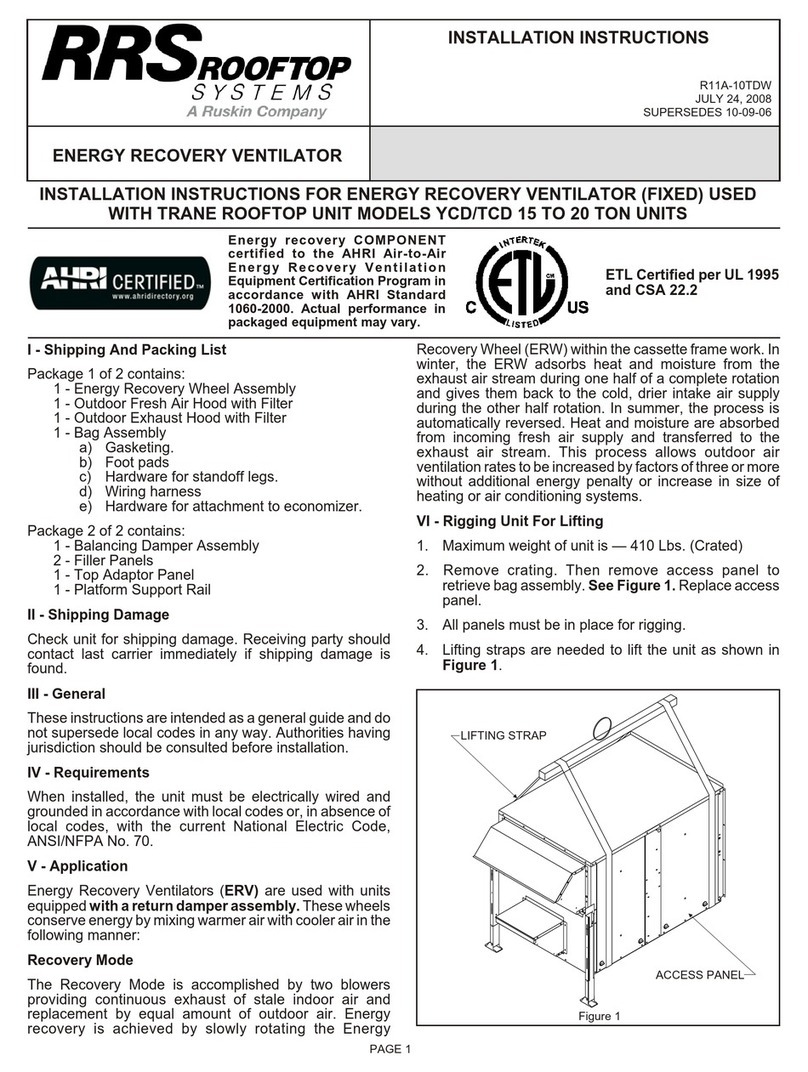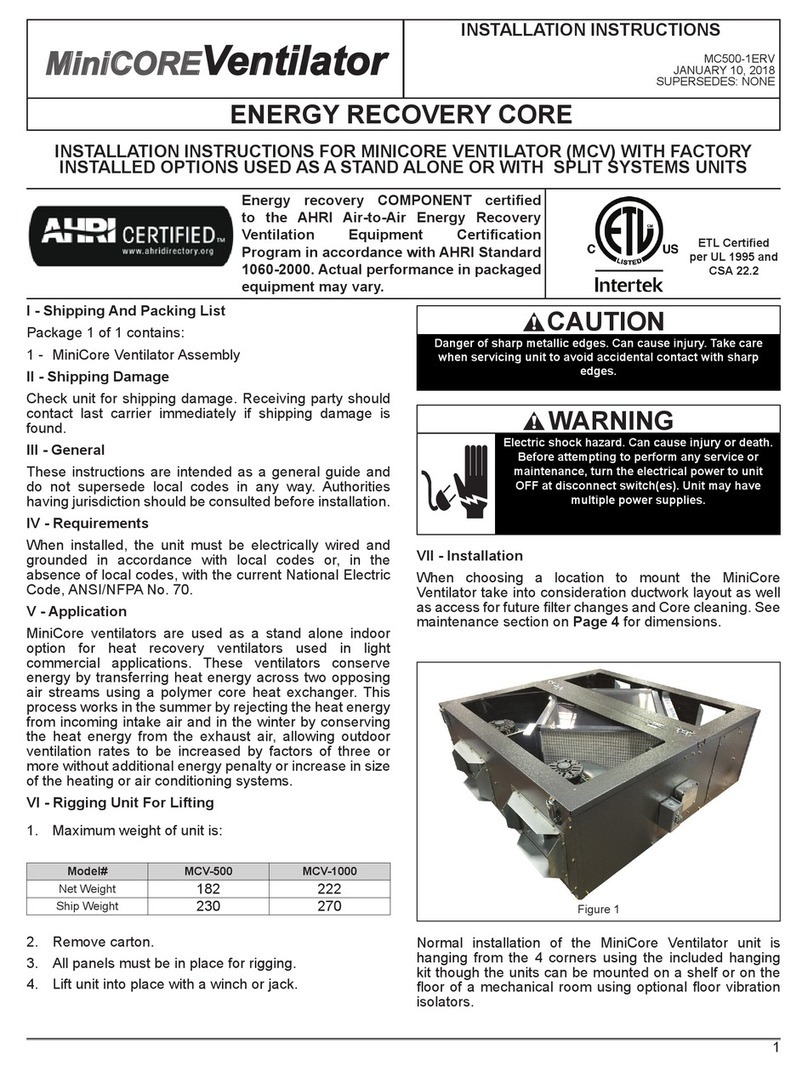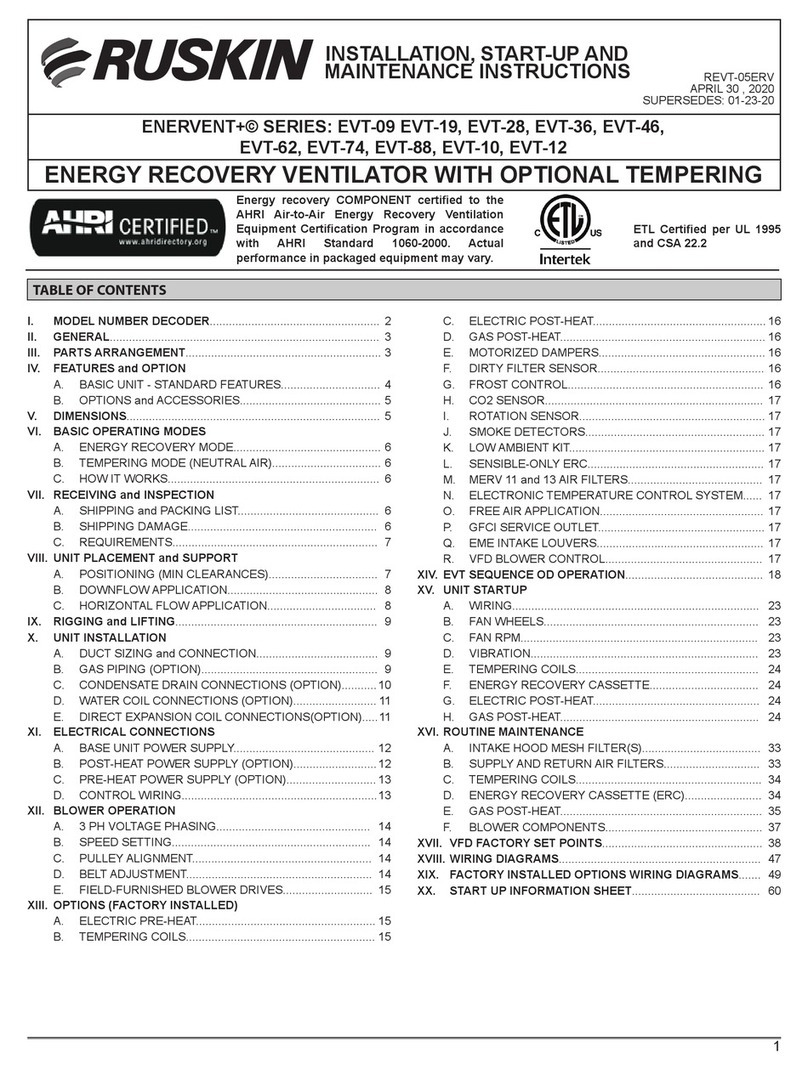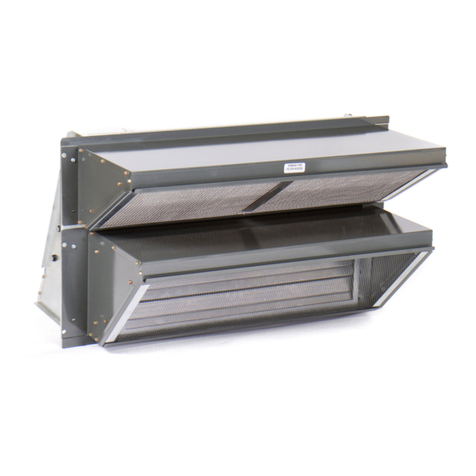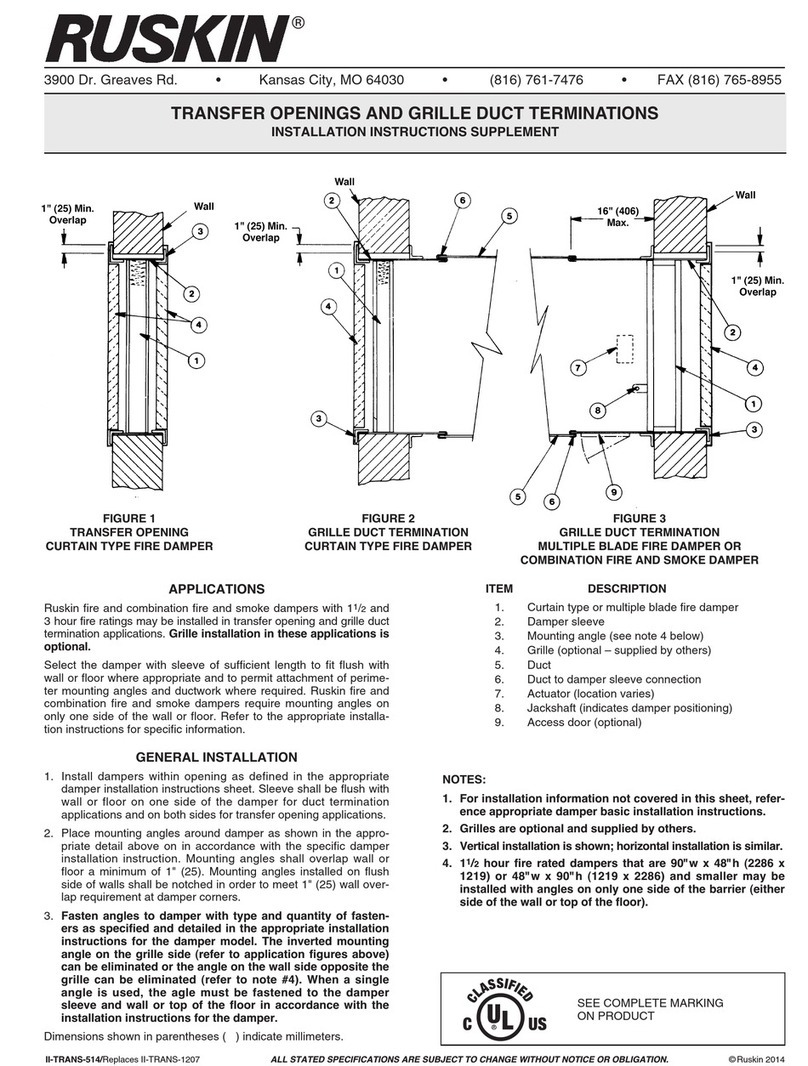
16. Insert and secure top filler panel under top flange of
rooftop unit and against top flange of ERV.
17. Seal, if required, along face (top and sides) of ERV unit
where it meets rooftop unit to insure no air leakage.
18. Locate the enthalpy control sensor removed earlier
from the rooftop unit. Remove the connectors and
wires from its terminals.
19. Remove the screws to the top panel of the fresh air
hood on the ERV labeled "filter access". Push up the
top panel and remove the air filter. Reinstall the
enthalpy control sensor with self-tapping screws on
the right side panel of the fresh air intake hood.
20. Remove the ERV access panels. Locate the bundle of
wires on the top deck. Route the blue and purple wires
to the enthalpy control sensor. Connect the purple wire
to the "+" terminal on the enthalpy control and the blue
wire to the "S" terminal. See field wiring diagram.
21. Remove ERV support block to allow wheel rotation
when unit is placed in operation.
22. All electrical connections must conform to any local
codes and current National Electric Codes (NEC) and
Canadian Electric Codes (CEC). Refer closely to unit
wiring diagram in unit and/or in these instructions for
proper wiring connections. Refer to the unit nameplate
for minimum circuit ampacity and maximum
overcurrent protection size. Electrical data is listed on
unit rating plate and motor nameplates.
23. Connect line voltage power to ERV from rooftop unit
disconnect switch through the knock out. Connect the
line voltage to the ERV control box per the wiring
diagram.
24. Ground unit with a suitable ground connection either
through unit supply wiring or earth ground.
Note: Unit voltage entries must be sealed weather
tight after wiring is complete.
25. Replace access panels onto the ERV unit and secure.
26. Restore power to unit.
27. Balancing is done by removing the plastic plugs in
door panels (4 total).
28. With a manometer measure pressure drop [ inches of
water column] across the top half of ERV (top holes in
door panel). Unit CFM is determined by referring to
Table #1. If CFM values are not per design, adjust
internal damper setting inside rooftop unit. This
accomplished by loosing set screw on damper frame
of positioning rod or slide damper. The repeat
measurement method.
29. Place plastic plugs back into door panels
30. Cleanup once ERV is operating properly. Caulk any
open joints, holes or seams to make the unit
completely air and water tight.
31. Leave this instruction manual with owner or in an
envelope to be kept near the unit.
PAGE 3
VIII - OPERATION
How It Works
The unit contains an Energy Recovery Wheel (ERW) that
is a new concept in rotary air-to-air heat exchanger.
Designed as a packaged unit for ease of installation and
maintenance, only matching up to rooftop unit with an
internal economizer and connection of electrical power is
required to make the system operational. The concept
consists of a unique rotary energy recovery wheel that
rotates in and out of fresh air streams within a heavy duty,
permanently installed blower cabinet that provides ready
access to all internal components. The media is polymeric
material that is coated and permanently bonded with a dry
desiccant for total enthalpy recovery. The wheel is belt
driven by PSC motor and drive belt.
When slowly rotating through counter flowing exhaust and
fresh air streams the ERV adsorbs sensible heat and latent
heat from the warmer air stream and transfer this total
energy to the cooler air stream during the second half of its
rotating cycle. Rotating at 60 revolutions per minute, the
wheel provides constant flow of energy from warmer to
cooler air stream. The large energy transfer surface and
laminar flow through the wheel causes this constant flow
of recovered energy to represent up to 85% of the
difference in total energy contained within the two air
streams.
Sensible and latent heat are the two components of total
heat. Sensible heat is energy contained in dry air and latent
heat is the energy contained within the moisture of the air.
The latent heat load from the outdoor fresh air on an air
conditioning system can often be two to three times that of
the sensible heat load and in the winter it is a significant
part of a humidification heat load.
During both the summer and winter, the ERV transfers
moisture entirely in the vapor phase. This eliminates wet
surfaces that retain dust and promote fungal growth as well
as the need for a condensate pan and drain to carry water.
Because it is constantly rotating when in the air stream, the
ERV is always being cleared by air, first in one direction
then the other. Because it is always dry, dust or other
particles impinging on the surface during one half cycle,
are readily removed during the next half cycle.
Low Ambient Kit is appropriate for climates with limited
HVAC system operation when outdoor temperatures are
below 15oF.
The frost threshold is the outdoor temperature at which
frost will begin to form on the ERV wheel. For energy
recovery ventilators, the frost threshold is typically below
15oF. Frost threshold is dependent on indoor temperature
and humidity. The table shows how the frost threshold
temperatures vary depending on indoor conditions.
FROST THRESHOLD TEMPERATURE
INDOOR RH AT
70oF
FROST THRESHOLD
TEMPERATURE
20% 0oF
30% 5oF
40% 10oF
Because Energy Recovery Ventilators have a low frost
threshold, frost control options are not necessary in many
climates. Where outdoor temperatures may drop below
the frost threshold during the ERV operational hours,
exhaust only frost control option is available.






